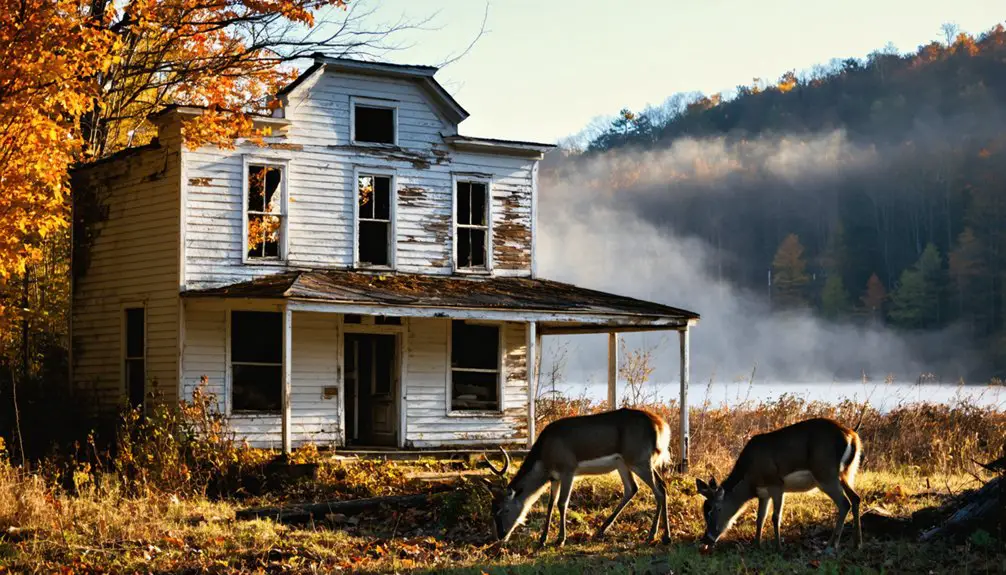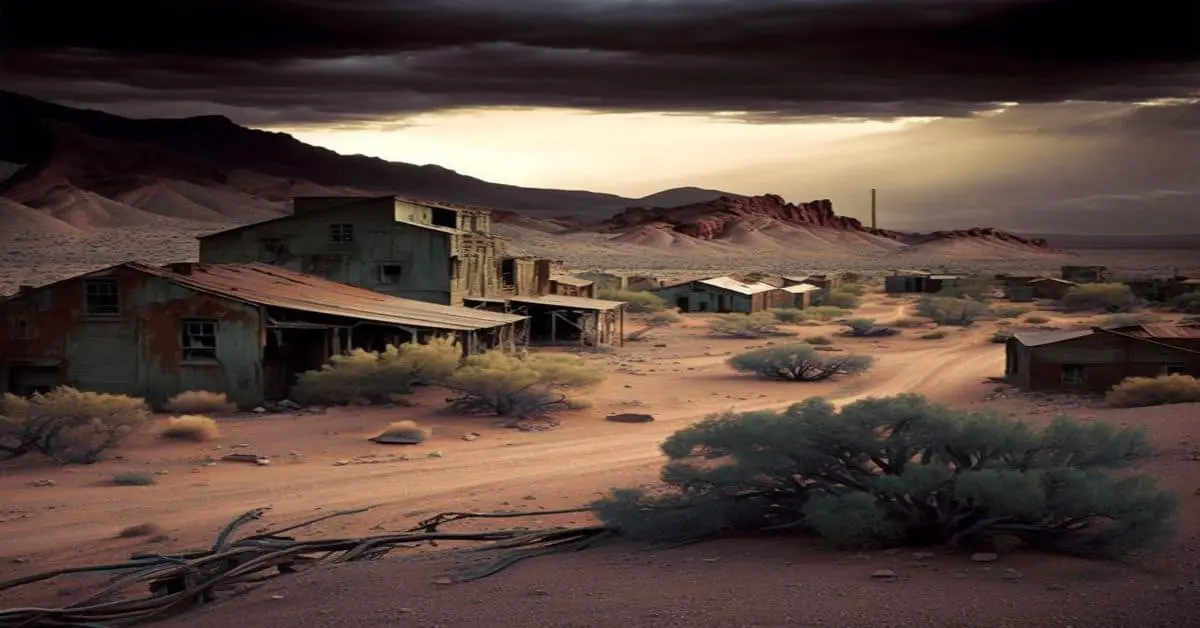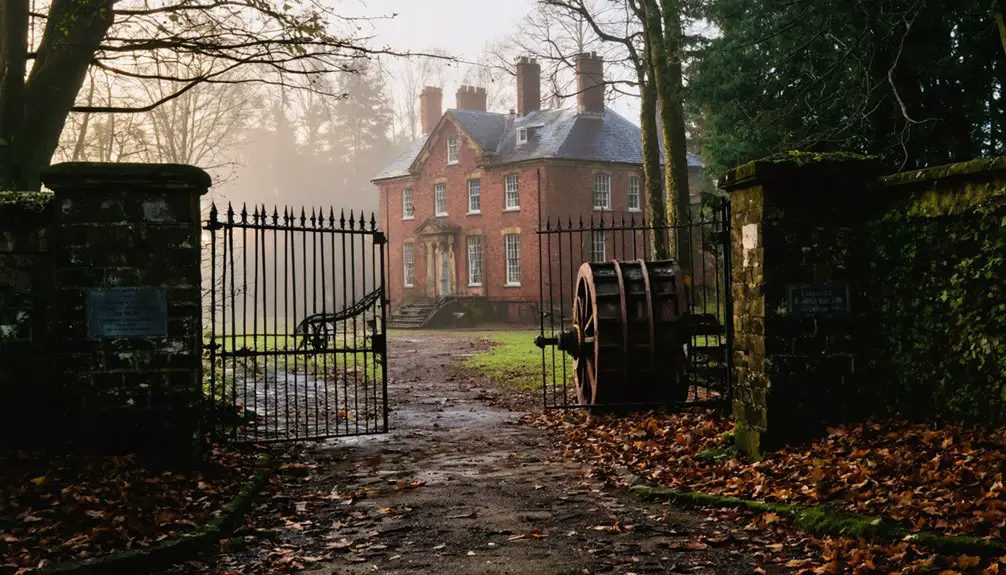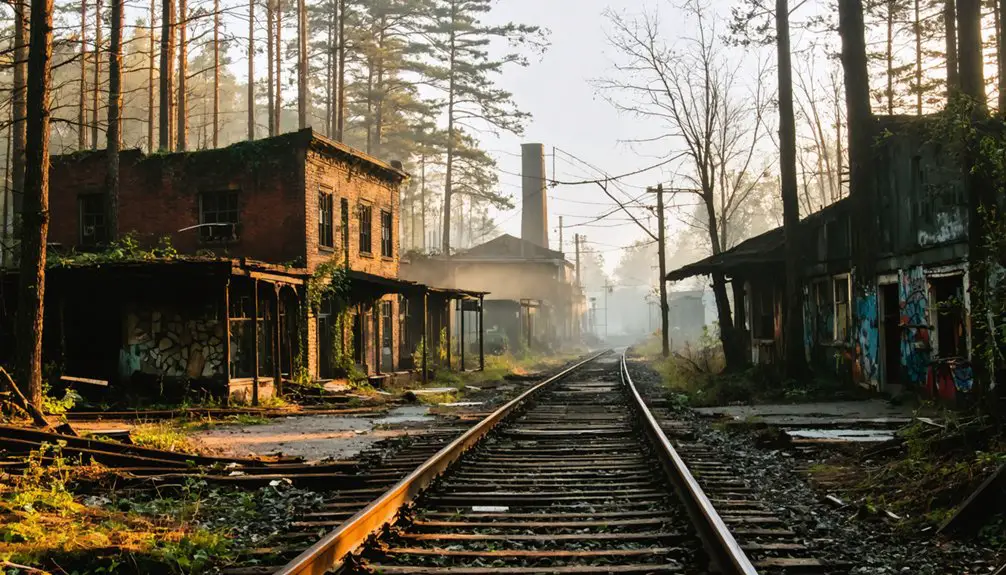You’ll find Walpack Center tucked away in Sussex County’s remote wilderness, where eleven preserved 19th-century buildings stand frozen in time. This former farming community thrived along Old Mine Road until 1965, when the controversial Tocks Island Dam Project forced residents to abandon their homes through eminent domain. Today, you can explore the historic district’s abandoned post office, church, and homes while discovering how nature has reclaimed this remarkable piece of New Jersey’s past.
Key Takeaways
- Walpack Center became a ghost town in 1965 when residents were forcibly displaced by the Tocks Island Dam Project through eminent domain.
- The abandoned village preserves eleven historic 19th-century buildings, including a post office and church, listed on the National Register.
- The failed dam project transformed Walpack Center into part of Delaware Water Gap National Recreation Area, protecting its natural wilderness.
- Walpack Historical Society maintains the ghost town’s buildings and offers public tours from May through October on Sundays.
- Once a thriving agricultural community since the 1800s, Walpack Center now stands as a preserved reminder of early rural New Jersey life.
The Rise of a Rural Farming Community
As settlers established farms throughout Sussex County in the early 1700s, Walpack Center emerged in the mid-1800s as an important service hub for the surrounding agricultural community.
You’d find small-scale farmers working the fertile valley lands, employing traditional farming techniques to cultivate fields and tend to livestock. The village’s strategic location near the Delaware River provided essential access to trade routes and communication with neighboring regions.
The community’s lifeblood flowed through its central amenities – a post office, church, and schoolhouse – where farmers gathered to conduct business and maintain social bonds. Since the 1800s, Walpack Center sustained itself as a close-knit farming community, fostering strong agricultural traditions.
Community life centered around these vital gathering places, where neighbors forged lasting connections through commerce, worship, and education.
This community interdependence proved critical for survival, as families relied on each other and local merchants for supplies, services, and support in their agricultural pursuits. The historic Old Mine Road, built by Dutch settlers in the mid-1600s, served as a vital commercial route connecting the farming community to broader markets.
Life Along Old Mine Road
The historic Old Mine Road, stretching 104 miles from New Jersey to New York, shaped the development of Walpack Center and its surrounding communities.
You’ll find traces of rich cultural heritage along this ancient pathway, which began as Native American trails used by the Lenape people over 12,000 years ago.
Life along Old Mine Road reflected unique community dynamics, where Dutch colonial influences blended with indigenous traditions. The Dutch first explored the area in the 1600s seeking mineral deposits in the mountains.
You’d have encountered thriving farming villages, welcoming guesthouses, and landmarks like the Van Campen Inn and Ferncliff Hotel.
The road’s remoteness fostered close-knit rural communities, with local economies centered around agriculture and hospitality for travelers.
While many historic structures have vanished, the road’s preserved sections within the Delaware Water Gap National Recreation Area still tell stories of early American settlement and commerce.
During the French and Indian Wars, settlers found protection in eight fortified houses built approximately eight miles apart along the Delaware River.
The Tocks Island Dam Project’s Impact
When Congress authorized the Tocks Island Dam project in 1962, it set in motion one of the most controversial federal initiatives to impact the Delaware River Valley.
The massive dam construction would’ve created a 37-mile-long reservoir, promising flood control, hydroelectric power, and recreation for 10.5 million annual visitors.
The proposed dam promised a mammoth 37-mile reservoir that would generate power and draw millions while taming the Delaware’s floods.
But the cost was steep – you’d have seen the forced displacement of 4,000 families through eminent domain as the government acquired 72,000 acres.
The project devastated tight-knit communities like Walpack Center, where families who’d farmed for generations were uprooted from their ancestral lands.
Despite the Army Corps of Engineers’ determination to complete the dam, growing opposition from environmental groups and local residents ultimately prevailed.
While the dam was never built, the community displacement had already transformed the valley, leaving ghost towns in its wake.
Initial geological studies in 1934 revealed that the proposed dam site was unsuitable for construction, but this warning was ignored when the project was revived decades later.
The project’s turbulent history included nearly 8,000 land parcels marked for condemnation, with thousands of structures ultimately destroyed.
Preservation Efforts and Historical Recognition
You’ll find Walpack Center’s historical significance formally recognized through its 1980 designation on the National Register of Historic Places, which protects eleven key buildings in the village center.
The Walpack Historical Society partners closely with the National Park Service to preserve these structures, with volunteers contributing significant hands-on work in restoration projects and artifact collection. The Rosenkrans Museum stands as one of the few buildings regularly open to visitors.
Through their combined efforts, you can now visit meticulously preserved 19th-century buildings like the church, post office, and historic houses that showcase early rural New Jersey life. The village faced a dramatic change when residents were evicted in 1965 to make way for the Delaware Water Gap National Recreation Area.
National Register Recognition
Following its extensive documentation of architectural and cultural significance, Walpack Center earned designation as a Historic District on the National Register of Historic Places in July 1980, encompassing 16 acres and eight contributing buildings.
This historic designation highlights the district’s importance in agriculture, architecture, and early settlement history, while preserving its architectural integrity through various Late Victorian and Italianate styles. Today, the site is an integral part of the Delaware Water Gap recreation area.
- You’ll find a beautifully preserved c.1856 one-room schoolhouse representing rural education
- The 1871 Italianate-style Methodist Church stands as a symbol of the community’s spiritual heritage
- The Walpack Parsonage, rebuilt in 1893, showcases Victorian-era craftsmanship
- The district’s listing on both national and state registers guarantees preservation funding eligibility and technical support
This recognition reinforces the site’s role in preserving Sussex County’s 19th-century agricultural heritage.
Volunteer Society Initiatives
The Walpack Historical Society stands at the forefront of preservation efforts for this historically significant district, working hand-in-hand with National Park Service maintenance crews to protect and restore Walpack Center’s architectural heritage.
You’ll find dedicated volunteers engaging in essential restoration work on historic structures like the post office, church, schoolhouse, and parsonage. Their volunteer engagement extends beyond physical preservation to include organizing public tours and Revolutionary War re-enactments at the Van Campen Inn.
The society’s commitment to historical preservation includes maintaining a valuable repository of local artifacts and documents.
Despite challenges like limited funding and the site’s remote location, these passionate volunteers continue coordinating with park services to combat decay and neglect, ensuring Walpack Center’s story endures for future generations to explore and appreciate.
Natural Beauty and Environmental Significance

You’ll find Walpack Center nestled within the pristine Delaware Water Gap National Recreation Area, where the scenic Delaware River winds through protected forests and mountains.
The untouched wilderness surrounding the ghost town provides critical habitats for native wildlife species, benefiting from decades of limited human interference since the area’s abandonment in the 1960s. The once-thriving farming community established in the 1800s now stands as a testament to nature’s reclamation of the land.
The location’s natural beauty is enhanced by its position along the Delaware River corridor, where you can observe diverse ecosystems thriving within the preserved landscape of Sussex County’s northwestern wilderness.
Scenic Delaware River Views
Nestled along the Delaware River Scenic Byway, Walpack Center offers visitors stunning panoramic views of one of America’s most historic waterways.
You’ll discover prime scenic overlooks and river photography opportunities along the 33-mile route, with vantage points revealing classic river valley features like cliffs, wetlands, and historic farmsteads.
- Hike Baldpate Mountain’s trails for sweeping views of the Delaware River and surrounding countryside
- Explore Bull’s Island Recreation Area’s 80 acres of forested terrain with elevated river perspectives
- Walk the historic D&R Canal towpath for continuous riverside vistas dating back to the 1830s
- Capture the contrast between tranquil river scenes and remnants of industrial heritage
The federally protected Wild and Scenic River section preserves the Delaware’s natural beauty while supporting activities like hiking, kayaking, and wildlife observation.
Protected Wildlife Habitats
Beyond the scenic river views, Walpack Center harbors a rich tapestry of protected wildlife habitats within its Wildlife Management Area, designated in 2008 by the New Jersey State Division of Fish and Game.
You’ll discover extensive hardwood forests, wetlands, and early successional areas that support diverse wildlife populations native to the Northeastern US.
The area’s wildlife conservation efforts focus on maintaining natural ecological processes through habitat restoration projects and controlled burns.
You’ll find pristine swamps that act as natural water filters, while the varied flora provides vital resources for local species.
The protected landscape plays an essential role in carbon sequestration and climate regulation.
Regular monitoring of fish and wildlife populations guarantees the continued health of this remarkable ecosystem within the Delaware Water Gap region.
Exploring the Abandoned Buildings Today
While many ghost towns have succumbed completely to decay, Walpack Center’s abandoned buildings remain remarkably preserved under the stewardship of the National Park Service.
You’ll find a fascinating collection of 19th-century structures perfect for urban exploration, including a historic post office, church, schoolhouse, and period homes. The historical architecture stands as a tribute to the village’s farming heritage, though some buildings show the inevitable signs of abandonment.
- Visit the museum on Sundays (May-October) to learn the town’s compelling history
- Walk Main Street to discover multiple abandoned homes dating to the 1800s
- Explore safely viewable exteriors of preserved structures along Route 615
- Join Walpack Historical Society tours for rare glimpses inside select buildings
Legacy of a Lost American Town
Walpack Center stands as a poignant tribute to America’s lost rural communities, frozen in time since its 1950s abandonment.
You’ll find more than just empty buildings here – you’re witnessing a reflection of community resilience that spans three centuries of American history, from Dutch miners in the 1600s to mid-20th century farmers.
The town’s historical significance extends beyond its architectural remnants.
You’re looking at a living museum that tells the story of how government infrastructure projects, like the unrealized Tocks Island Dam, could displace entire communities.
Walpack Center remains a stark testament to how ambitious federal projects can uproot and erase established communities overnight.
Today, preserved by the National Park Service and Walpack Historical Society, these white-painted buildings and centuries-old gravestones offer you a rare glimpse into rural American life and serve as a reminder of how quickly thriving communities can vanish.
Frequently Asked Questions
Are There Any Reported Paranormal Activities or Ghost Sightings in Walpack Center?
You’ll find anecdotal ghost sightings in online videos and social media, but there aren’t any officially documented paranormal investigations or confirmed supernatural events, despite the town’s reputation for spooky atmosphere.
What Happened to the Displaced Residents After They Were Forced to Leave?
Once rooted in farmland, now scattered to cities – you’ll find these displaced residents relocated to nearby towns across New Jersey and neighboring states, forever changing the historical impact of their centuries-old community.
Can Visitors Stay Overnight in Any of the Remaining Buildings?
You can’t stay overnight in the abandoned buildings, but you’ll find modern accommodations at the nearby Walpack Inn and its cabin, which offers comfortable lodging with full amenities for adult guests.
Does Anyone Still Maintain Private Property Rights Within the Historic District?
Like oases in a desert, private ownership still thrives within the historic district. You’ll find several inhabited homes, including historic homesteads along Old Mine Road, where owners maintain their property rights under preservation guidelines.
What Are the Specific Rules and Regulations for Photographing the Buildings?
You’ll need permits for commercial photography, while personal photos are allowed without permits. You can’t enter buildings without authorization, and you must respect all access restrictions and property boundaries.
References
- https://www.worldatlas.com/cities/you-won-t-believe-this-town-is-in-new-jersey.html
- https://www.jerseysbest.com/community/take-a-road-trip-through-n-j-s-spooky-ghost-towns-to-see-peculiar-pieces-of-history/
- https://www.youtube.com/watch?v=7zrVdmxo9kM
- https://scenesfromthetrail.com/2016/09/10/walpack-township-abandoned-in-new-jersey/
- https://walpackhistory.org/walpack-new-jersey/
- https://npshistory.com/publications/dewa/spanning-the-gap/v11-2-1.pdf
- https://en.wikipedia.org/wiki/Wallpack_Center
- https://walpackhistory.org/places/
- https://www.nps.gov/dewa/learn/historyculture/touring-old-mine-road.htm
- https://en.wikipedia.org/wiki/Old_Mine_Road



